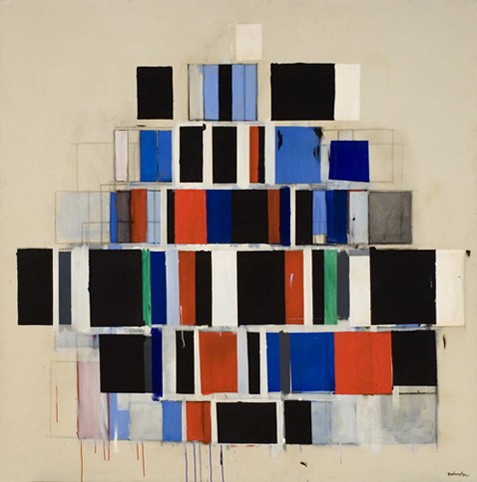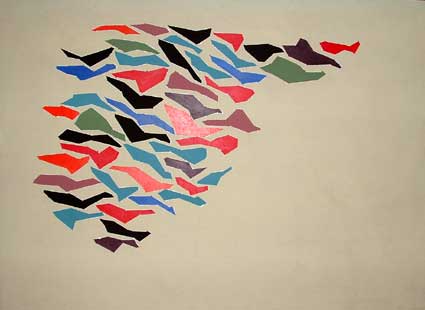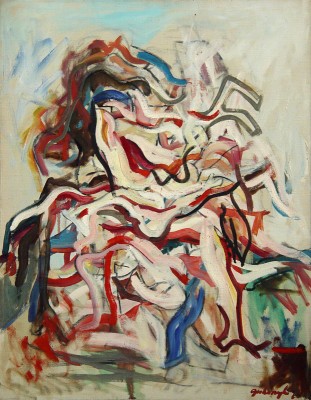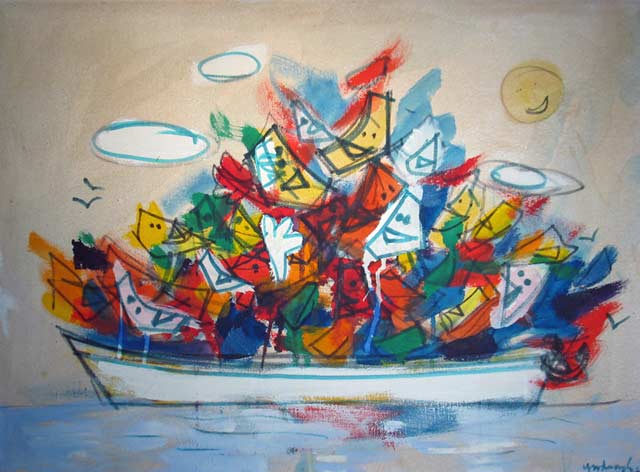<Back to Index>
- Painter Robert Henry De Niro, Sr., 1922
- Painter Robert Goodnough, 1917
PAGE SPONSOR

Robert Henry De Niro, Sr. (January 17, 1922 – May 3, 1993) was an American abstract expressionist painter and the father of actor Robert De Niro.
Robert De Niro, Sr., was born in Syracuse, New York, to an Italian - American father, Henry Martin De Niro (1897 – 1976), whose parents emigrated from Ferrazzano, in the province of Campobasso, Molise, and an Irish American mother, Helen M. (née O'Reilly; 1899 – 1999). He was the eldest of three children; he and siblings John and Joan were raised in Syracuse, New York. Robert De Niro Sr. studied at the renowned Black Mountain College under Josef Albers from 1939 to 1940. While Albers' highly analytical approach to painting did not appeal to De Niro's more instinctive style, the experience and international perspective of the Bauhaus master nonetheless left a lasting impression. De Niro studied with Hans Hofmann at his Provincetown, Massachusetts, summer school. Hofmann's teaching, focused on Abstract Expressionism and Cubist formalism, had a strong influence on De Niro's development as a mature artist.
At Hofmann's summer school, he met fellow student Virginia Admiral, whom he married in 1942. The couple moved into a large, airy loft in New York's Greenwich Village, where they were able to paint. They surrounded themselves with an illustrious circle of friends, including writers Anaïs Nin and Henry Miller, playwright Tennessee Williams and the actress and famous Berlin dancer Valeska Gert. Admiral and De Niro separated shortly after their son, Robert De Niro, Jr., was born in August 1943.
De Niro attended Black Mountain College in the 1950s. Being a self proclaimed perfectionist, De Niro painted and repainted his canvases again and again. He would do hundreds of studies before he decided to paint the subject.
In 1945, De Niro was included in the Fall exhibition at Peggy Guggenheim's The Art of This Century gallery on 57th Street in New York. Reviews of the exhibition praised the work of De Niro as well as that of Jackson Pollock and Mark Rothko. He had his first solo exhibition at The Art of This Century the following year.
De Niro had a series of solo exhibitions in the 1950s at the Charles Egan Gallery in New York, which exhibited the work of Willem de Kooning and other early abstract expressionist artists. By the mid 1950s, De Niro was regularly included in important group exhibitions such as the Whitney Annual, the Stable Annual, and the Jewish Museum.
From 1961 - 1964, De Niro traveled to France to paint in
Paris and in the surrounding countryside. Collector Joseph
Hirshhorn purchased a number of the artist's paintings and
works on paper during this period through De Niro's
gallerist, Virginia Zabriskie, which are now in the
permanent collection of the Hirshhorn Museum and Sculpture
Garden in Washington, DC. In 1968, he was awarded a
Guggenheim Fellowship.
Throughout the 1970s and 1980s, De Niro continued to exhibit in museums and galleries throughout the United States, including New York, San Francisco, Kansas City, Los Angeles, and Washington, D.C. He taught at several art schools and colleges including the Cooper Union, the New School for Social Research, the School of Visual Arts, and East Michigan State College.
His work is included in several museum collections including the Brooklyn Museum, Baltimore Museum of Art, Mint Museum, Hirshhorn Museum, Kansas City Art Institute and the Yellowstone Museum Art Center.
Robert De Niro was a visiting artist at Michigan State University's Department of Art in the early 1960s.
In 2007, son Robert De Niro threatened legal action against the Benucci S.r.l. art gallery, in Rome, Italy, after it allegedly took a number of his father's paintings from a New York arthouse to settle a $5 million debt.
DC Moore Gallery represents the Estate of Robert De Niro, Sr. The first exhibition of his works at the gallery was in April 2012.
Robert De Niro, Sr., died of cancer at age 71, on the
morning of Monday, May 3, 1993, in New York City.
He is interred at Kensico Cemetery in Valhalla, New York.
The film A Bronx Tale was dedicated to him after
his death; it was the directorial debut of his son, Robert
De Niro, Jr.
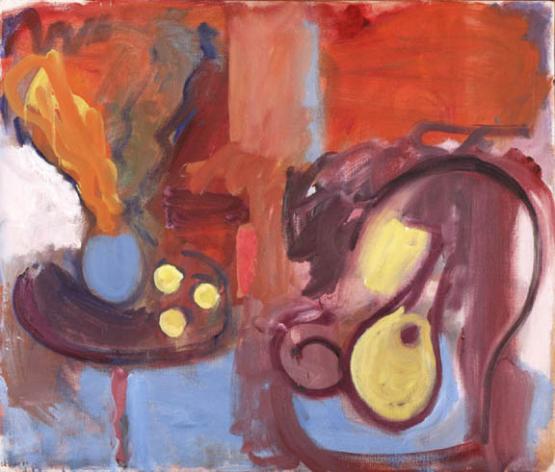
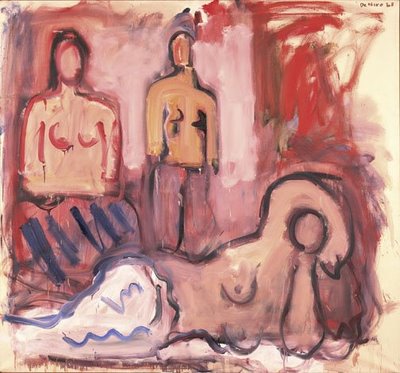
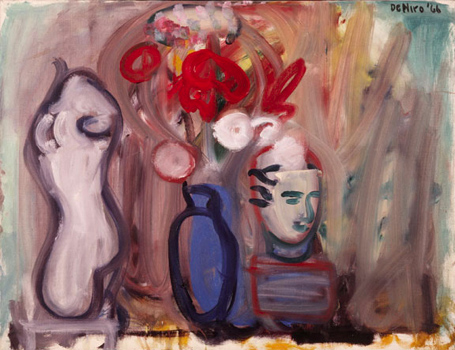
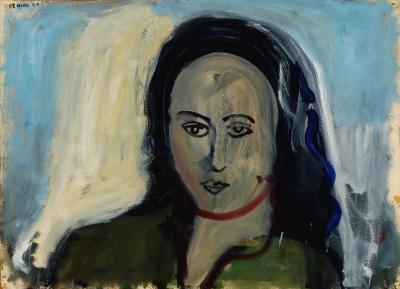

Robert Goodnough (October 23, 1917 – October 2, 2010) was an American abstract expressionist painter. A veteran of World War II, Goodnough was one of the last of the original generation of the New York School; (although he has been referred to as a member of the "second generation" of Abstract Expressionists), even though he began exhibiting his work in galleries in New York City in the early 1950s. Robert Goodnough was among the 24 artists from the total of 256 participants who were included in the famous 9th Street Art Exhibition (1951) and in all the following New York Painting and Sculpture Annuals from 1953 to 1957. These Annuals were important because the participants were chosen by the artists themselves.
Early in his career starting in 1950 he showed his paintings at the Wittenborn Gallery, NYC. He had shown at the Tibor de Nagy Gallery in New York City from 1952 to 1970 and again from 1984 to 1986. In 1960 and 1961 he had solo exhibitions at The Art Institute of Chicago. A veteran of scores of solo exhibitions and hundreds of group exhibitions in the United States and abroad, Goodnough also had solo exhibitions in 1969 at the Whitney Museum of American Art in NYC and the Albright - Knox Art Gallery in Buffalo. In later years his paintings were also associated with the Color Field movement.
During the 1940s Goodnough graduated from Syracuse
University and served in the U.S.
Army during World War II. After the war in 1946
he attended the Ozenfant School of Fine Arts in New York
and the Hans Hofmann summer school in Provincetown,
Massachusetts. He earned his masters degree from New York
University in 1950 after which he began to exhibit his
paintings publicly and also to write articles for ARTnews
magazine.
